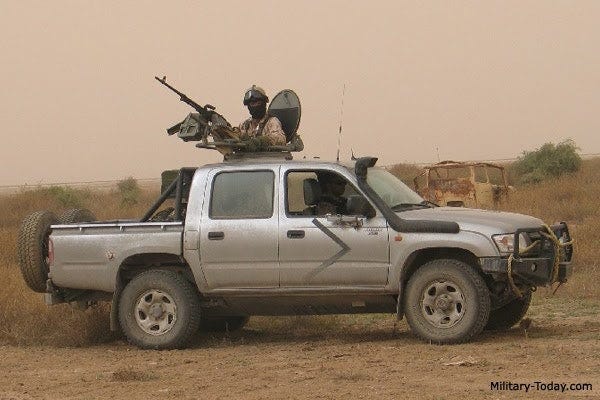We’re launching subscriptions for WITI. If you’ve been a loyal reader, we’d love for you to sign up. We’re keeping the weekday editions open, and are launching a beta WITI weekend edition for subscribers. Thanks for your readership over these 2.5 years of daily editions and we will continue to build this into a great platform for intellectual omnivores. We appreciate it! -Colin and Noah
Colin here. If I told you to squint your eyes and envision a desert terrorism scenario, chances are this vision would involve militants driving around in a makeshift gun truck: a pickup with a belt-fed machine gun attached to the top, manned by a standing soldier.
It is a familiar image, and the term for this, a technical, originated in the Somali Civil War. NGOs hired local gunmen to protect their men, and paid from “technical assistance grants.” The term now basically means any jury-rigged truck with fighters in it. The brand preference is often a Toyota, specifically a Hi-Lux, known for durability in austere conditions.
According to the Economist:
In Mali and Niger smugglers transporting people and goods across the Sahara will accept no alternative, since they can cram 30 people onto one and can still climb a sand dune. It is also a familiar sight in African war zones, as the vehicle of choice for anyone who wants to create a “technical”—a pickup truck with a machine gun mounted on the back. This is not the kind of publicity that Toyota craves. The firm says it has “a strict policy” not to sell vehicles to those “who may use or modify them for paramilitary or terrorist activities”. But this is hard to enforce. Buyers do not say: “I’m going to mount a gun on it.”
Why is this interesting?
Why and how does a car that your average citizen could buy at a dealership, find itself transported into some of the most far-flung places of conflict in the world? According to a deep dive on the subject from War on the Rocks, there’s a simple reason:
Today, primarily irregular, infantry-centric forces fight almost every conflict in the world. Pickup trucks are their mainstays. In Afghanistan, Sudan, Somalia, Iraq, Mexico, Syria, Libya, Mali and the Central African Republic, irregulars reach the battlefield more often than not in the cabs and beds of Toyota Hi-Luxes and Land Cruisers, Ford Rangers, and Mitsubishi L200s. When they arrive, the same pickups are often carrying the crew-served weapons that offer a light force to pack a punch on the cheap. Pickup trucks are ideal for the wars of the twenty-first century: they’re readily available, cheap, fuel efficient, easy to operate and repair. And, they are more modular than the Littoral Combat Ship. They can operate off-road in the bush or in the downtown of a major metropolis. All of these characteristics make the pickup truck a war-winner for non-state or weak-state forces that can’t get their hands on purpose-built military vehicles, can’t afford extensive logistic chains, and need to quickly move through and between rough terrain and urban environments.
There’s even a war named after these technicals. “The Toyota War” was the last phase of the 1987 Chadian–Libyan conflict, set in Northern Chad and on the Libyan–Chadian border. It got its name from, “The speedy all-terrain mobility of the Chadian technicals allowed them to cross the Sahara into Libya undetected, masking their approach by following wadis and dunes. The trucks could carry the heavy weapons necessary to destroy Libyan armor and suppress Libyan positions at long range, unlike infantry or camels.”
But how exactly does the supply chain work? Can one get a militia discount? How do these trucks get purchased and find their way into conflict, the same way arms do? The Economist cites a Global Witness study saying:
On April 5th Global Witness, a watchdog, published a study showing how at least one paramilitary group, Sudan’s Rapid Support Forces (rsf), a semi-official band of thugs with roots in the Darfur conflict, bought more than 1,000 Toyota Hiluxes and Land Cruisers to convert into technicals. Many such were seen at roadblocks last year after a bloody massacre of civilian protesters. The purchases hint at the worrying way in which power in Sudan is still a function of access to money and weapons, a year after the revolution that overturned the 30-year dictatorship of Omar al-Bashir.
Global Witness acquired a spreadsheet that seems to have been made by the rsf to track its purchases. By checking pictures of rsf technicals on social media, ship manifests and satellite imagery, Global Witness claims it was able to corroborate the information in it. The organisation claims that the rsf bought Toyota pickup trucks in the Gulf through two rsf front companies that are also linked to gold trading. This is a business in which the rsf’s commander, Mohamed Hamdan Dagalo (known as “Hemedti”), has a big interest. Despite the militia’s official status the money used to pay for the vehicles seems not to have come from the Sudanese state
The hacking and iteration of these war machines continues to evolve. Syrian rebels created a makeshift tank powered by, wait for it, a Playstation controller. As conflict grows more asymmetric, unconventional, and dispersed, it is a sure bet that sightings of these iconic trucks will remain on our television screens for times to come. (CJN)
Video of the Day:
This four-part Toyota Hilux durability test video is amazing. (NRB)
Quick Links:
Show the injuries (NRB)
Was just reminded of this very good NYT piece on brain injuries in sledding sports (NRB)
WITI x McKinsey:
An ongoing partnership where we highlight interesting McKinsey research, writing, and data.
A life in full. Indra Nooyi, former chairman and CEO of PepsiCo, is a trailblazer—she was the first woman of color and immigrant to run a Fortune 50 company. But how'd she manage a demanding career and a growing family, and what did she learn along the way? Find out in a can't-miss interview from McKinsey's Author Talks series.
--
Thanks for reading,
Noah (NRB) & Colin (CJN)
—
Why is this interesting? is a daily email from Noah Brier & Colin Nagy (and friends!) about interesting things. If you’ve enjoyed this edition, please consider forwarding it to a friend. If you’re reading it for the first time, consider subscribing.




